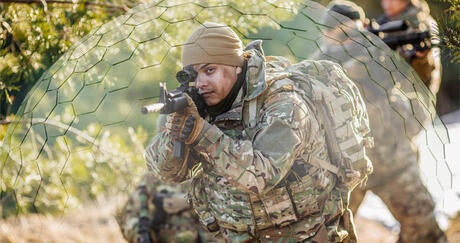When networked closely together, these assets become an essential force multiplier, enabling seamless communication and timely sense and effect capabilities at different locations within the battlespace. This allows forces to deliver multiple cyber electromagnetic activity (CEMA) effects at a moment’s notice, from counter-IED to electronic surveillance to electronic attack, so they can consistently outperform and outsmart the adversary while staying out of harm’s way.
Networked EW at Everest NL
Against the picturesque backdrop of Experience Island located in the Netherlands, L3Harris recently demonstrated this capability at Everest NL – a live, immersive C5ISR experiment. Here, the company explored its ability to create a highly adaptable battle network to provide connectivity for software-defined, multi-role EW equipment tasked to deliver different effects in different areas at pace.
With portable, lightweight Individual CORVUS Nodes (ICNs) distributed across the environment and a Configurable CORVUS System (CCS) fixed at the experiment’s headquarters, each of these multi-role systems acted as sensors or effectors generating and collecting vital intelligence. All sensors were networked together and fed into a consolidated interface, providing important insights to enhance decision-making and inform a rapid response to the scenario’s threats.
Networking the EW nodes together resulted in speeding up the intelligence cycle to enable faster decisions and ultimately increase lethality. A CORVUS-RAVEN counter-small uncrewed aircraft system (UAS) was also connected to the wider network, enabling drone threats across the island to be detected as necessary with the option to inhibit from the same node.
The many advantages of networked EW
There are several key reasons the CORVUS portfolio works so successfully in an EW network:
- Rapid re-tasking
ICN and CCS are both software-defined radio systems and are designed to enable multi-role, multi-function capability. This means operators in the field are able to easily re-task a node to switch from one capability to another, often in less than a minute. Different effects can therefore be quickly delivered in different locations as needed, swiftly changing from surveillance-based, data collecting tasks to counter-based capabilities such as jamming.
- Open, modular architecture
The CORVUS architecture is built on open standards, allowing developers to introduce new capabilities and applications for new effects much faster. Thanks to OpenCPI, customers are given the autonomy to develop their own applications, or deliver apps from third parties, at will. This means no vendor lock-in, and provides the perfect opportunity for greater investment in sovereign, European capability.
- Common interfaces and interoperability
Highly interoperable and easy to adapt, the CORVUS architecture enables interfaces to easily consume and share information with allied systems to help provide a live, holistic view of the battlespace and prevent friendly fire through Blue Force tracking. What’s more, even if communications are denied across the environment, CORVUS still provides valuable situational awareness capability at a local level.
- Ready for non-specialist users
At present, forces are limited by the availability of EW specialists – particularly across NATO countries. As a result, EW is increasingly the responsibility of everyone on the team. CORVUS makes EW equipment and capability more user-friendly and accessible to the non-specialist user, helping to democratize EW across the battlefield.
The many advantages of the CORVUS portfolio make it an ideal candidate for achieving an interoperable, networked EW solution. EVEREST NL demonstrated this clearly, using techniques such as time difference of arrival (TDOA), in-phase quadrature (IQ) streaming and direction finding, among others. This compelling scenario leveraged L3Harris equipment already in-service, showing how quickly and successfully such a capability can be delivered and put to work.






